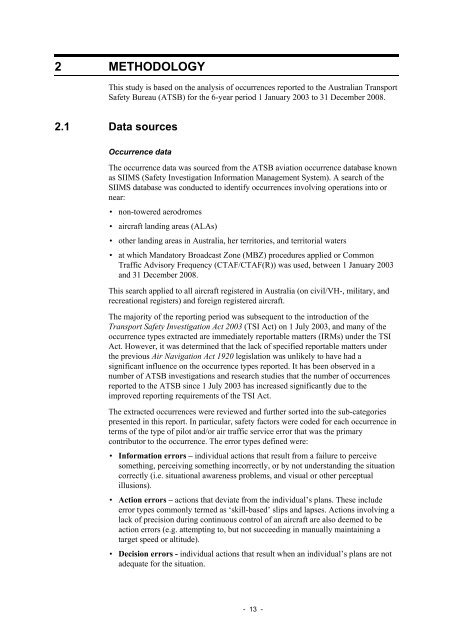Safety in the vicinity of non-towered aerodromes - Australian ...
Safety in the vicinity of non-towered aerodromes - Australian ...
Safety in the vicinity of non-towered aerodromes - Australian ...
Create successful ePaper yourself
Turn your PDF publications into a flip-book with our unique Google optimized e-Paper software.
2 METHODOLOGY<br />
This study is based on <strong>the</strong> analysis <strong>of</strong> occurrences reported to <strong>the</strong> <strong>Australian</strong> Transport<br />
<strong>Safety</strong> Bureau (ATSB) for <strong>the</strong> 6-year period 1 January 2003 to 31 December 2008.<br />
2.1 Data sources<br />
Occurrence data<br />
The occurrence data was sourced from <strong>the</strong> ATSB aviation occurrence database known<br />
as SIIMS (<strong>Safety</strong> Investigation Information Management System). A search <strong>of</strong> <strong>the</strong><br />
SIIMS database was conducted to identify occurrences <strong>in</strong>volv<strong>in</strong>g operations <strong>in</strong>to or<br />
near:<br />
• <strong>non</strong>-<strong>towered</strong> <strong>aerodromes</strong><br />
• aircraft land<strong>in</strong>g areas (ALAs)<br />
• o<strong>the</strong>r land<strong>in</strong>g areas <strong>in</strong> Australia, her territories, and territorial waters<br />
• at which Mandatory Broadcast Zone (MBZ) procedures applied or Common<br />
Traffic Advisory Frequency (CTAF/CTAF(R)) was used, between 1 January 2003<br />
and 31 December 2008.<br />
This search applied to all aircraft registered <strong>in</strong> Australia (on civil/VH-, military, and<br />
recreational registers) and foreign registered aircraft.<br />
The majority <strong>of</strong> <strong>the</strong> report<strong>in</strong>g period was subsequent to <strong>the</strong> <strong>in</strong>troduction <strong>of</strong> <strong>the</strong><br />
Transport <strong>Safety</strong> Investigation Act 2003 (TSI Act) on 1 July 2003, and many <strong>of</strong> <strong>the</strong><br />
occurrence types extracted are immediately reportable matters (IRMs) under <strong>the</strong> TSI<br />
Act. However, it was determ<strong>in</strong>ed that <strong>the</strong> lack <strong>of</strong> specified reportable matters under<br />
<strong>the</strong> previous Air Navigation Act 1920 legislation was unlikely to have had a<br />
significant <strong>in</strong>fluence on <strong>the</strong> occurrence types reported. It has been observed <strong>in</strong> a<br />
number <strong>of</strong> ATSB <strong>in</strong>vestigations and research studies that <strong>the</strong> number <strong>of</strong> occurrences<br />
reported to <strong>the</strong> ATSB s<strong>in</strong>ce 1 July 2003 has <strong>in</strong>creased significantly due to <strong>the</strong><br />
improved report<strong>in</strong>g requirements <strong>of</strong> <strong>the</strong> TSI Act.<br />
The extracted occurrences were reviewed and fur<strong>the</strong>r sorted <strong>in</strong>to <strong>the</strong> sub-categories<br />
presented <strong>in</strong> this report. In particular, safety factors were coded for each occurrence <strong>in</strong><br />
terms <strong>of</strong> <strong>the</strong> type <strong>of</strong> pilot and/or air traffic service error that was <strong>the</strong> primary<br />
contributor to <strong>the</strong> occurrence. The error types def<strong>in</strong>ed were:<br />
• Information errors – <strong>in</strong>dividual actions that result from a failure to perceive<br />
someth<strong>in</strong>g, perceiv<strong>in</strong>g someth<strong>in</strong>g <strong>in</strong>correctly, or by not understand<strong>in</strong>g <strong>the</strong> situation<br />
correctly (i.e. situational awareness problems, and visual or o<strong>the</strong>r perceptual<br />
illusions).<br />
• Action errors – actions that deviate from <strong>the</strong> <strong>in</strong>dividual’s plans. These <strong>in</strong>clude<br />
error types commonly termed as ‘skill-based’ slips and lapses. Actions <strong>in</strong>volv<strong>in</strong>g a<br />
lack <strong>of</strong> precision dur<strong>in</strong>g cont<strong>in</strong>uous control <strong>of</strong> an aircraft are also deemed to be<br />
action errors (e.g. attempt<strong>in</strong>g to, but not succeed<strong>in</strong>g <strong>in</strong> manually ma<strong>in</strong>ta<strong>in</strong><strong>in</strong>g a<br />
target speed or altitude).<br />
• Decision errors - <strong>in</strong>dividual actions that result when an <strong>in</strong>dividual’s plans are not<br />
adequate for <strong>the</strong> situation.<br />
- 13 -
















